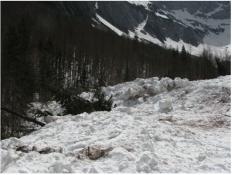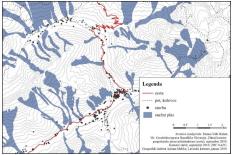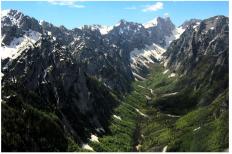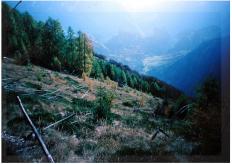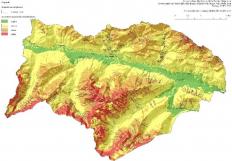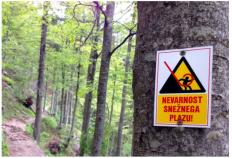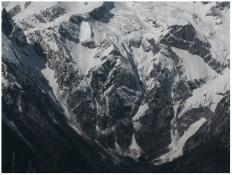Avalanche hazard management using terrain classification analysis
Principal Investigator at ZRC SAZU
Blaž Komac, PhD-
Original Title
Upravljanje lavinske nevarnosti s pomočjo klasifikacije reliefa
Project Team
Manca Volk Bahun, PhD, Mauro Hrvatin, PhD, Jure Tičar, PhD, Miha Pavšek, MA, Rok Ciglič, PhD, Mateja Ferk, PhD, Matej Lipar, PhD, Matija Zorn, PhD, dr. Andrej Šmuc, Andrej Novak, prof. dr. Tom Tomislav Levanič, Robert Krajnc-
Project ID
J6-2591
-
Duration
1 September 2020–31 August 2023 -
SICRIS
SICRIS -
Lead Partner
-
Project Leader
Blaž Komac, Ph.D.
-
Financial Source
ARIS - Slovenian Research and Innovation Agency

Partners
Faculty of Natural Sciences and Engineernig, University of Ljubljana, Slovenian Forestry Institute
Research Gap: Compared to the neighboring Alpine countries, in Slovenia the avalanche issue is not well known and, most importantly, it is not addressed comprehensively. The emergency response and aid during such disasters are well provided for, but the analysis of their occurrence, and hazard prediction and management are not. Due to increased burdens on the environment and land use individualization, there is a growing demand for understanding avalanche-prone areas.
Contents of the Project: This project will pay special attention to the impact of the terrain, which forms the avalanche starting zone, track, and deposition zone (or runout).
Avalanches are common in Slovenia. In terms of scale, they cannot be compared to other natural disasters that “threaten the lives or health of people and animals, and property, and cause damage to cultural heritage and the environment to the extent that requires the use of special measures, forces, and means” (Mikoš 2014, 309), but they nonetheless impact people.
Even though they adapted their dwellings to the avalanche-prone terrain, in recent decades human activity has again extended increasingly into the avalanche-prone areas: the population and its mobility is increasing, and leisure activities also take place in the mountains. Therefore, avalanches are responsible for the largest number of deaths in the Alps and affect the transport and tourism infrastructure: in Slovenia, certain sections of roads (e.g., over the Vršič mountain pass) and railway lines (e.g., Jesenice–Most na Soči), and certain tourist areas, such as the Vogel and Kanin ski slopes, are often closed.
Due to climate change and increasing human activity in avalanche-prone areas, avalanches are going to present a greater landscape management challenge in the future. Even though they will be less frequent, they will be more extensive due to more frequent extreme precipitation events; over 120 cm of fresh snow within 24 hours have already been recorded twice on Mount Kredarica over the past decade. A thick spring snow cover at lower elevations is also becoming typical, which is associated with the development of glide avalanches that have been less well-known to date and result from a rapid, late transition from a warm autumn into a snowy winter.
Compared to the neighboring Alpine countries, in Slovenia the avalanche issue is not well known and, most importantly, it is not addressed comprehensively. Like with most natural disasters, avalanches, too, are most often dealt with only after they occur. The emergency response and aid during such disasters are well provided for, but the analysis of their occurrence and hazard prediction and management are not. Due to increased burdens on the environment and land use individualization, there is a growing demand for understanding avalanche-prone areas, protective measures, and managing landscapes affected by avalanches.
WORKPLAN
During the Project we are going to:
1) Expand the findings to date and fill the knowledge gap of avalanche dependence on terrain characteristics, such as slope inclination, curvature, roughness, and length, and produce an avalanche terrain classification. We will analyze the characteristics of various avalanche terrain types, such as areas with no avalanches, avalanche starting zones and starting zones of- various types of avalanches (e.g., powder avalanches or full-depth avalanches), ridges with frequent snow cornices, avalanche tracks where the slope length, dissection by gullies, and surface roughness are important, and avalanche deposition zones, where buildings and infrastructure can be at risk of being buried.
2) The analysis will be enriched by local studies on the Vršič Pass, Zelenica Mountain ant Torkla Village. The research will use physical geographical analyses, including drone filming, which will provide data to support the avalanche terrain classification. Dynamic models will be used to describe avalanche movement. The results will be supplemented through dendrochronological analyses, which have not been used to provide insight into past avalanche phenomena in Slovenia.
3) The results will be presented in the Avalanche Atlas of Slovenia that will inform the public about avalanche hazard and the past events.
4) This project will explore the impact of climate change on avalanches in Slovenia, which will contribute to a better understanding of the future occurrence of avalanches in time and space.
5) As part of this project, the Guidelines for Managing Avalanche Hazards in Alpine Regions will be produced for various stakeholders who deal with avalanche hazards in their work.
Gallery:
Expected projec results: As part of this project, an avalanche terrain classification for an avalanche occurrence model will be produced and tested at the local level, an avalanche atlas will be compiled, and guidelines for managing avalanche hazards in the Slovenian Alps will be designed.
The results of this project will contribute to resilience and thus greater safety and reduce the threat to the population. Because this is the first pure-research project focusing on avalanches in geography, it will have a great social and strategic impact. The project results will include Avalanche atlas and Guidelines that will provide a model for dealing with other natural disasters that affect the Alpine environment.
Reports:
- Komac, B., Pavšek, M., Volk Bahun, M., Tičar, J. 2021: Snežni plazovi v dolini Soče 22. in 23. januarja 2021. Poročilo o raziskavah. ZRC SAZU, Geografski inštitut Antona Melika. Ljubljana, 16. februar 2021.
- Volk Bahun, M., Hrvatin, M., Komac, B. 2022: Determining potential snow avalanche release areas by relief analysis. GIS v Sloveniji 16: Preteklost in prihodnost. Ljubljana.
- Komac, B., Zorn, M. 2022: Impact of climate on snowpack and avalanches in Slovenia: The Soča Valley case study. Geographia Polonica 96-1.
- Geographical Atlas of Natural Disasters in Slovenia. ZRC SAZU Anton Melik Geographical Institute, 2023. Ljubljana.
